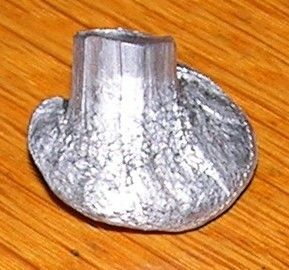F/A = .00000697 · ((WrV²) / (Pldn)) I did the calc for my 150 gr in the AR308. 4389 psi? Very close to my calc a few years ago, for the rifling engaging psi. Once the boolit is spinning, force drops by x10. Couple years ago I did some 'twist till break' tests on HT #2 30 cal rifle (RD mould). I could apply ~ 30# with 6" vise grips and get a breaking force of ~360#, ~4741 psi. The weak point is a the lube grooves (smaller dia), so this is a good formula. I posted a psi number (435 psi) for softening of HT Pb62%Sn, which is close to HT #2 alloy. Note that number is NOT for fracture, just the force applied to a disk used to measure the BHN (Hv - vickers hardness) of the alloy. The Hv at the disk center remained ~10, IIRC ~ 3 at the edge, indicating that the alloy softening occurs primarily at the outside of our boolits AND doesn't recover while moving down the barrel. We wonder why we get gas cutting? It also adds some validity to Larry G's twist vs accuracy discussion. Also adds validity for Cu jackets & to some extent, PCing.
A flat nose boolit is less stable than a round nose of the same length primarily because the FN slows down faster and enters the transonic region earlier (~mach 1.5-0.8).

|
   
   
|


|




 Reply With Quote
Reply With Quote

















